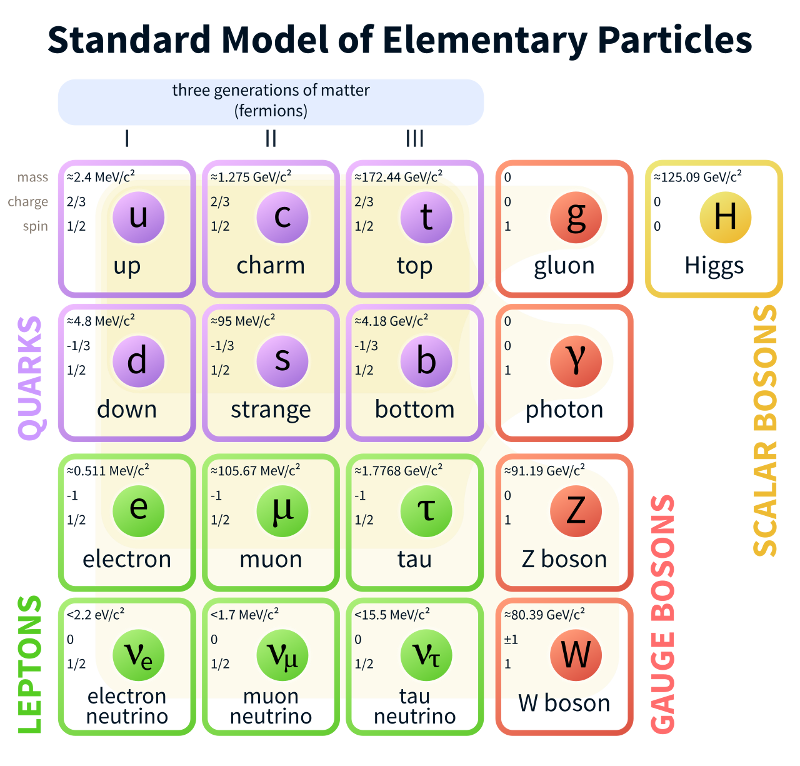Research on Neutrinos and NuLat
NuLat is currently under construction and being tested at UH
Manoa and Virginia Tech. It is a compact, segmented, fast-timing
anti-neutrino detector that aims to detect neutrinos at short
baselines.
Neutrinos
What are neutrinos? Neutrinos are small (nearly
massless) subatomic particles with no charge. More specifically,
they are fermions that interact only via the weak nuclear force
and gravity, making them very difficult to detect. Currently,
there are three known neutrinos, the electron neutrino, muon
neutrino, and tau neutrino, though there may be a fourth 'sterile
neutrino' that does not interact with the nuclear force. Below, we
see the neutrinos as included in the standard model of elementary
particles:
Research on Neutrinos
There are several active branches of research related to
neutrinos:
- Detector design - physicists and engineers are looking for
new and innovate ways to detect neutrinos. As they have no
charge and are extremely light, most neutrinos pass through
matter without interacting at all. However, very rarely, a
neutrino can interact, creating other particle and eventually
light which can be detected. This usually take large detectors
like Super-K, shown below with physicist Neil deGrasse Tyson
rowing inside, with a huge volume of target material for the
neutrino to interact with. As a result, scientists are looking
for ways to detect more neutrinos with less material.
- Directional detection - as physicists develop more efficient
and more compact neutrino detectors, they are also searching
for better methods to determine the direction a neutrino came
from. This might seem trivial. After all, when we take a photo
of something we often know exactly which direction the light
came from. We are also able to track the movement of
electrons, muons, and other particles fairly well. Neutrinos,
however, don't have electric charge, making them very
difficult to track, and they usually don't interact with the
front surface of our detector. Instead, they enter the inside
and on very rare occasions they cause a reaction there, giving
off a small amount of light that only offers hints at the
original trajectory.
- Neutrino masses - the exact masses of the three neutrinos
still remain unknown. Because they're so light, they deposit
only a small amount of energy when interacting with other
particles, making it a huge challenge to get a precise
measurement of their masses.
- Neutrino oscillations - Neutrinos, it turns out, are
shape-shifters. Though they are created with a particular
lepton 'flavor' (electron, muon, or tau), they can later be
observed to have a different flavor because the particle
oscillates quantum mechanically as it moves through space.
These oscillations were first postulated in 1957 and their
eventual discovery was award the 2015 Nobel Prize in Physics.
Deficits and anomalies in neutrino rates at reactors indicate
that there may be a fourth, 'sterile' neutrino that the other
three can oscillate into.
- Cosmic background neutrinos - You may be familiar with the
Cosmic Microwave Background, a background of micowave energy
left behind after the big bang. Similarly, there should be a
sea of low energy neutrinos left over from shortly after the
universe's birth. These neutrinos, however, should have
extremely low energies (with a temperature of 1.95 K, very
close to absolute zero), making them even more difficult to
detect than neutrinos from reactors, stars, and other sources.
Applications
Possible applications for compact neutrino detectors include
nuclear non-proliferation studies, compact reactor monitoring,
remote reactor monitoring, hunts for nuclear material and
contaminants spread by hostile entities, sterile neutrino
searches, and studies of nuclear decay chains.
Neutrinos offer a fresh window into such nuclear processes,
whether they're occurring inside a reactor, a weapon, a star, or
the center of the Earth. As uncharged particle, they easily pass
through large amounts of matter and shielding, giving us an early
hint at what's happening inside.
For example, a neutrino detector could be deployed outside of a
well-shielded facility to observe reaction rates inside. This
might be beneficial in the event of an emergency, or as a backup
to existing systems. Studies of the neutrino energy spectrum from
reactors are also beginning to shed light on the complex decay
chains inside, which are not always well-documented or fully
understood, partly due to the
pandemonium
effect.
There may also be other undiscovered possibilities. When the
electron was
discovered
by J. J. Thomson in 1897, it would have been almost
impossible for him to imagine the plethora of technologies and
devices that utilize our understanding of the humble particle
today. Likewise, though they may seem tiny and insignificant,
neutrinos may have untold secret utilities that await discovery by
the physicists of the future.



